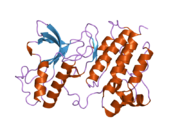c-Met
| edit |
c-Met (MET, receptor hepatocitnog faktora rasta, HGFR),[1][2] protein je koji je kod ljudi kodiran MET genom (MET proto-onkogena receptorska tirozinska kinaza). U ranijem razdoblju istraživačkog procesa takođe je nazivan MNNG HOS transformišući gen. Ova protein deluje kao tirozinska kinaza.[3] Primarni jednolančani prekursorni protein se posttranslaciono preseca i time se formiraju alfa i beta podjedinica, koje se disulfidno vezuju pri formiraju krajnjeg oblika receptora.
MET je membranski receptor koji je esencijalan za embrionsko razviće i zarastanje rana. Hepatocitni faktor rasta (HGF) je jedini poznati ligand MET receptora. MET je normalno izražen u ćelijama epitelnog porekla, dok je izražavanje HGF ograničeno na ćelije mesenhimalnog porekla. Nakon HGF stimulacije, MET indukuje nekoliko bioloških responsa koji kolektivno formiraju program poznat kao invazivni rast.
Interakcije[uredi | uredi kod]
Met formira interakcije sa:
Vidi još[uredi | uredi kod]
Reference[uredi | uredi kod]
- ↑ Bottaro DP, Rubin JS, Faletto DL, Chan AM, Kmiecik TE, Vande Woude GF, Stuart A. Aaronson (February 1991). „Identification of the hepatocyte growth factor receptor as the met proto-oncogene product”. Science 251 (4995): 802–4. DOI:10.1126/science.1846706. PMID 1846706.
- ↑ Galland F, Stefanova M, Lafage M, Birnbaum D (1992). „Localization of the 5' end of the MCF2 oncogene to human chromosome 15q15----q23”. Cytogenet. Cell Genet. 60 (2): 114–6. DOI:10.1159/000133316. PMID 1611909.
- ↑ Cooper CS (January 1992). „The met oncogene: from detection by transfection to transmembrane receptor for hepatocyte growth factor”. Oncogene 7 (1): 3–7. PMID 1531516.
- ↑ Davies G, Jiang WG, Mason MD (2001). „HGF/SF modifies the interaction between its receptor c-Met, and the E-cadherin/catenin complex in prostate cancer cells”. Int. J. Mol. Med. 7 (4): 385–8. DOI:10.3892/ijmm.7.4.385. PMID 11254878.
- ↑ Petrelli A, Gilestro GF, Lanzardo S, Comoglio PM, Migone N, Giordano S (2002). „The endophilin-CIN85-Cbl complex mediates ligand-dependent downregulation of c-Met”. Nature 416 (6877): 187–90. DOI:10.1038/416187a. PMID 11894096.
- ↑ Ng C, Jackson RA, Buschdorf JP, Sun Q, Guy GR, Sivaraman J (2008). „Structural basis for a novel intrapeptidyl H-bond and reverse binding of c-Cbl-TKB domain substrates”. EMBO J. 27 (5): 804–16. DOI:10.1038/emboj.2008.18. PMC 2265755. PMID 18273061.
- ↑ Grisendi S, Chambraud B, Gout I, Comoglio PM, Crepaldi T (2001). „Ligand-regulated binding of FAP68 to the hepatocyte growth factor receptor”. J. Biol. Chem. 276 (49): 46632–8. DOI:10.1074/jbc.M104323200. PMID 11571281.
- ↑ Ponzetto C, Zhen Z, Audero E, Maina F, Bardelli A, Basile ML, Giordano S, Narsimhan R, Comoglio P (1996). „Specific uncoupling of GRB2 from the Met receptor. Differential effects on transformation and motility”. J. Biol. Chem. 271 (24): 14119–23. DOI:10.1074/jbc.271.24.14119. PMID 8662889.
- ↑ Liang Q, Mohan RR, Chen L, Wilson SE (1998). „Signaling by HGF and KGF in corneal epithelial cells: Ras/MAP kinase and Jak-STAT pathways”. Invest. Ophthalmol. Vis. Sci. 39 (8): 1329–38. PMID 9660480.
- ↑ Comoglio PM (1993). „Structure, biosynthesis and biochemical properties of the HGF receptor in normal and malignant cells”. EXS 65: 131–65. PMID 8380735.
- ↑ Naldini L, Weidner KM, Vigna E, Gaudino G, Bardelli A, Ponzetto C, Narsimhan RP, Hartmann G, Zarnegar R, Michalopoulos GK (1991). „Scatter factor and hepatocyte growth factor are indistinguishable ligands for the MET receptor”. EMBO J. 10 (10): 2867–78. PMC 452997. PMID 1655405.
- ↑ Hiscox S, Jiang WG (1999). „Association of the HGF/SF receptor, c-met, with the cell-surface adhesion molecule, E-cadherin, and catenins in human tumor cells”. Biochem. Biophys. Res. Commun. 261 (2): 406–11. DOI:10.1006/bbrc.1999.1002. PMID 10425198.
- ↑ Wang D, Li Z, Messing EM, Wu G (2002). „Activation of Ras/Erk pathway by a novel MET-interacting protein RanBPM”. J. Biol. Chem. 277 (39): 36216–22. DOI:10.1074/jbc.M205111200. PMID 12147692.
Literatura[uredi | uredi kod]
- Peruzzi B, Bottaro DP (2006). „Targeting the c-Met signaling pathway in cancer”. Clin. Cancer Res. 12 (12): 3657–60. DOI:10.1158/1078-0432.CCR-06-0818. PMID 16778093.
- Birchmeier C, Birchmeier W, Gherardi E, Vande Woude GF (December 2003). „Met, metastasis, motility and more”. Nat. Rev. Mol. Cell Biol. 4 (12): 915–25. DOI:10.1038/nrm1261. PMID 14685170.
- Zhang YW, Vande Woude GF (February 2003). „HGF/SF-met signaling in the control of branching morphogenesis and invasion”. J. Cell. Biochem. 88 (2): 408–17. DOI:10.1002/jcb.10358. PMID 12520544.
- Paumelle R, Tulasne D, Kherrouche Z, Plaza S, Leroy C, Reveneau S, Vandenbunder B, Fafeur V, Tulashe D, Reveneau S (April 2002). „Hepatocyte growth factor/scatter factor activates the ETS1 transcription factor by a RAS-RAF-MEK-ERK signaling pathway”. Oncogene 21 (15): 2309–19. DOI:10.1038/sj.onc.1205297. PMID 11948414.
- Comoglio PM (1993). „Structure, biosynthesis and biochemical properties of the HGF receptor in normal and malignant cells”. EXS 65: 131–65. PMID 8380735.
- Maulik G, Shrikhande A, Kijima T, et al. (2002). „Role of the hepatocyte growth factor receptor, c-Met, in oncogenesis and potential for therapeutic inhibition”. Cytokine Growth Factor Rev. 13 (1): 41–59. DOI:10.1016/S1359-6101(01)00029-6. PMID 11750879.
- Ma PC, Maulik G, Christensen J, Salgia R (2004). „c-Met: structure, functions and potential for therapeutic inhibition”. Cancer Metastasis Rev. 22 (4): 309–25. DOI:10.1023/A:1023768811842. PMID 12884908.
- Knudsen BS, Edlund M (2004). „Prostate cancer and the met hepatocyte growth factor receptor”. Adv. Cancer Res.. Advances in Cancer Research 91: 31–67. DOI:10.1016/S0065-230X(04)91002-0. ISBN 978-0-12-006691-9. PMID 15327888.
- Dharmawardana PG, Giubellino A, Bottaro DP (2005). „Hereditary papillary renal carcinoma type I”. Curr. Mol. Med. 4 (8): 855–68. DOI:10.2174/1566524043359674. PMID 15579033.
- Kemp LE, Mulloy B, Gherardi E (2006). „Signalling by HGF/SF and Met: the role of heparan sulphate co-receptors”. Biochem. Soc. Trans. 34 (Pt 3): 414–7. DOI:10.1042/BST0340414. PMID 16709175.
Vanjske veze[uredi | uredi kod]
- MeSH Proto-Oncogene+Proteins+c-met
- UniProtKB/Swiss-Prot entry P08581: MET_HUMAN, ExPASy (Expert Protein Analysis System) proteomics server of the Swiss Institute of Bioinformatics (SIB)
- A table with references to significant roles of MET in cancer








